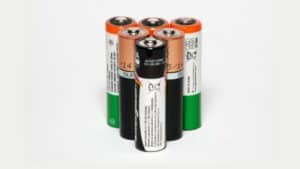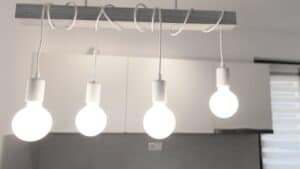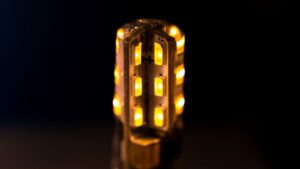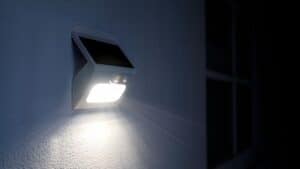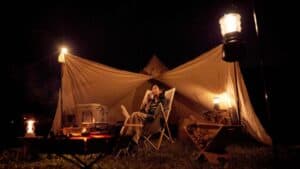Flashlights are an essential tool for a wide variety of applications, from navigating a power outage to exploring the great outdoors. With so many different types of flashlights available, it can be difficult to know which one is right for you.
This guide will provide a comprehensive overview of 16 different types of flashlights, as well as the factors to consider when choosing a flashlight and answers to frequently asked questions.

How Does a Flashlight Work?
A flashlight is a portable, battery-powered light source. The basic components of a flashlight are a battery, a light source (such as an LED or incandescent bulb), a reflector, and a switch. When the switch is turned on, it completes an electrical circuit, allowing power to flow from the battery to the light source. The reflector then focuses the light into a beam.
The main parts of a flashlight include:
- Power source (batteries)
- Conductor (metal contacts and wires)
- Switch (on/off mechanism)
- Light source (bulb or LED)
- Reflector (directs the light forward)
16 Types Of Flashlights
Flashlights come in various designs to suit different needs, from everyday carry to specialized applications requiring specific features like waterproofing or extreme brightness.
LED Flashlights
LED flashlights are among the most popular options on the market today, known for their energy efficiency and brightness. Utilizing light-emitting diodes, they consume less power, generate minimal heat, and can last up to 100,000 hours.
Modern designs often feature adjustable brightness settings, varying beam patterns, and lightweight, ergonomic shapes for comfort. LEDs are available in a spectrum of color temperatures, from warm yellow to cool blue-white, making them versatile for activities like map reading or searching in low light.
Lanterns
Lanterns provide 360-degree illumination, ideal for lighting entire spaces rather than focusing on a beam. LED technology ensures durability and energy efficiency, with models ranging from compact, pocket-sized designs to larger versions meant for camping or emergencies.
Many lanterns include practical features such as hanging hooks, flat bases, collapsible designs for easy storage, and USB ports for charging devices. Solar-powered options are ideal for extended off-grid use, while multiple lighting modes—such as reading lights or emergency signals—add to their versatility.
Headlamps
Headlamps offer hands-free lighting, making them indispensable for tasks requiring both illumination and manual dexterity. Mounted around the head, they direct light precisely where you look.
Modern headlamps utilize efficient LEDs, often with adjustable brightness and red light modes to preserve night vision during activities like stargazing or camping. Lightweight designs with adjustable straps enhance comfort, and advanced models incorporate motion sensors for gesture activation or rear red lights for group visibility. Battery life can range from a few hours on high to days on low settings.

Diving Lamp Flashlights
Diving lamp flashlights are engineered for underwater use, resisting high pressure and ensuring reliable performance in challenging aquatic conditions. With depth ratings often exceeding 200 meters, these flashlights are made from corrosion-resistant materials like anodized aluminum to withstand saltwater exposure.
Featuring wide, powerful beams that penetrate murky water, diving lights often include multiple power settings, wrist straps, and battery indicators for added security. Premium models offer specialized colors like blue or red for observing marine life and safety features such as automatic shutoff to prevent overheating underwater.
Heavy Duty Flashlights
Heavy duty flashlights are designed for durability and reliable performance in extreme conditions. Built from impact-resistant materials such as aircraft-grade aluminum or reinforced polymers, they can withstand significant drops and harsh environments. Weather-sealed to resist dust, dirt, and water, these flashlights thrive in challenging situations.
Most heavy duty models offer exceptionally bright illumination, with professional-grade options exceeding 10,000 lumens. Adjustable brightness modes help balance power consumption and runtime. Engineered for temperature extremes, they feature textured grips and anti-roll designs for secure handling in tough conditions.
Novelty Flashlights
Novelty flashlights focus on unique, creative designs rather than pure functionality. Shaped like animals, characters, vehicles, or other playful forms, they are popular with children and collectors. While less durable or bright than traditional flashlights, they often include features like sound effects, projections, or color-changing lights, making them fun and decorative.
Many novelty flashlights offer practical extras, such as keychain attachments or nightlight functions, blending utility with entertainment.
Pressurized Gas Flashlights
Pressurized gas flashlights use combustible gases, such as butane, instead of batteries to produce light. They create illumination via a flame that heats a mantle to incandescence. Highly reliable in extreme cold—where traditional batteries may fail—they can burn for hours on a single gas fill.
Though they require careful handling due to flammable fuel, modern designs include features like piezoelectric igniters for effortless starting. While less common today, these flashlights remain a favored tool for outdoor enthusiasts tackling extreme conditions.
Shake Flashlights
Shake flashlights, or faraday flashlights, generate power through kinetic energy. A magnet moves through a coil when shaken, creating an electrical current that charges a small capacitor or battery. A minute of shaking provides several minutes of modest light, making them ideal for emergencies or situations where batteries are unavailable.
Many shake flashlights incorporate additional charging methods, such as solar panels or hand cranks, and are built with durable, water-resistant designs for emergency preparedness. They also serve educational purposes, demonstrating electromagnetic principles in a practical, hands-on way.
Solar Powered Flashlights
Solar powered flashlights utilize photovoltaic panels to recharge internal batteries using sunlight, offering an eco-friendly alternative to disposable batteries or electrical outlets. While most require several hours of direct sunlight for a full charge, many models feature supplementary charging options like USB ports or hand cranks for overcast conditions.
Equipped with efficient LEDs, these flashlights maximize runtime from stored solar energy, with some including battery capacity indicators. The best designs balance panel size with portability and durability. Although not as bright as traditional flashlights, they are a reliable option for general use and emergencies.
Work Flashlight
Work flashlights are built for demanding environments like construction sites and industrial settings. They feature rugged, impact-resistant designs to endure drops and rough use. Many include practical features such as magnetic bases or hanging hooks for hands-free operation, making them especially useful for mechanics and electricians.
Typically offering brightness levels between 300 and 1000 lumens, work flashlights often provide adjustable settings for extended runtime. Wide-angle beams illuminate large areas, and water or dust resistance (IP65 or higher) ensures durability in challenging conditions.
Handheld Flashlights
Handheld flashlights are versatile tools available in a range of sizes, from compact models to larger, high-output versions. Designed with a cylindrical body housing the batteries, they deliver brightness ranging from 100 to over 2000 lumens, depending on the model.
Beam patterns vary from flood lighting (wide, short-range) to spotlighting (narrow, long-range), with most offering multiple modes including strobe and SOS. Modern models use LED technology for longevity and energy efficiency. They run on a variety of power sources, such as disposable (AA, AAA) or built-in rechargeable batteries.
Rechargeable Flashlights
Rechargeable flashlights are a sustainable and cost-effective alternative to disposable battery models. Powered by lithium-ion batteries, they feature charging methods ranging from USB ports (micro-USB, USB-C) to docks and wireless pads. Many include battery level indicators to avoid unexpected power loss.
They offer multiple brightness modes to balance runtime, and some high-end models double as power banks for charging other devices. Certain designs incorporate solar panels, making them ideal for off-grid activities like camping or emergency kits.
Tactical Flashlights
Tactical flashlights are built for military, law enforcement, and self-defense purposes, featuring rugged construction and high-performance capabilities. They are equipped with momentary-on switches for quick, controlled illumination without fully turning on the light—essential in tactical scenarios.
With brightness levels ranging from 300 to over 2000 lumens, these flashlights often produce intensely focused beams capable of temporarily disorienting an attacker. Many models include crenelated (strike) bezels for emergency self-defense.
Constructed from aircraft-grade aluminum with military-grade anodized finishes, tactical flashlights offer superior durability. Standard features include water and impact resistance and reliable operation in extreme temperatures.
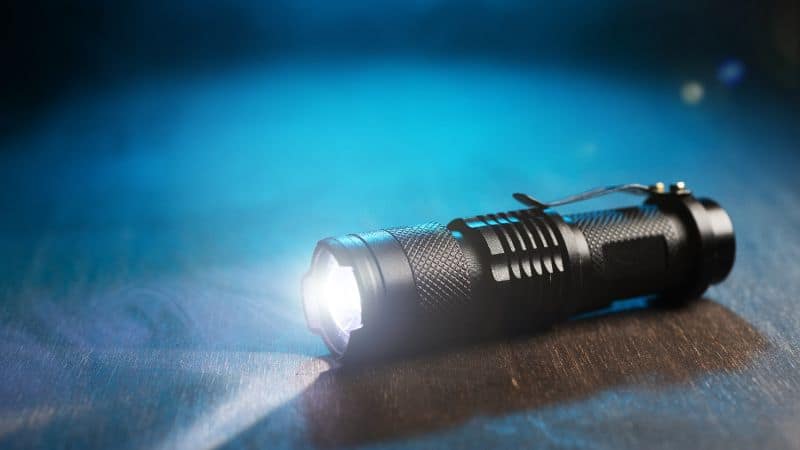
Mini And Keychain Flashlights
Mini and keychain flashlights emphasize portability and everyday convenience, making them ideal for carrying at all times. Typically under 3 inches in length and weighing less than 2 ounces, they are compact yet capable, with modern LEDs producing over 100 lumens of light.
Power sources include button cells, single AAA batteries, or small rechargeable batteries, offering runtimes from 30 minutes to several hours depending on the brightness setting. Many use twist-on activation to avoid accidental use and often include extra tools like bottle openers or glass breakers.
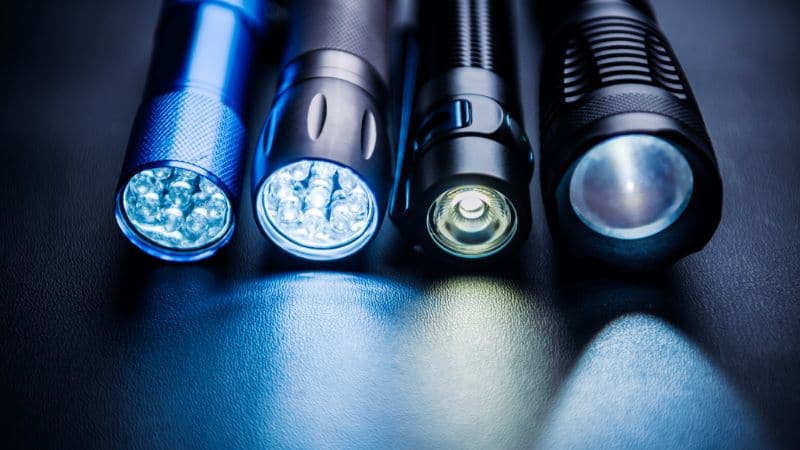
High-Intensity Discharge (HID) Flashlights
HID flashlights deliver unparalleled brightness by using xenon gas and metal halide salts to create a powerful electric arc. Producing between 3000 and 12,000 lumens, these flashlights generate bluish-white light that mimics daylight, ideal for high-intensity applications like search and rescue or cave exploration.
While exceptionally bright, HID flashlights require a ballast for voltage regulation, making them bulkier and heavier than LEDs. They also take 10–30 seconds to reach full brightness and have limited battery life, typically 30 minutes to 2 hours, due to high power demands.
Incandescent Flashlights
Incandescent flashlights use tungsten filament bulbs, a traditional technology largely replaced by LEDs but still available for specific uses. Their warm, yellowish light offers superior color rendering, making objects look more natural under illumination.
These flashlights are often cheaper upfront but come with shorter bulb lifespans (50–100 hours) and higher battery consumption. They generate significant heat, which is helpful in cold environments but less practical for extended or enclosed use.
Factors to Consider When Choosing a Flashlight
When choosing a flashlight, there are a number of factors to consider, including:
Brightness (Lumens)
Brightness, measured in lumens, determines how much light a flashlight emits. While higher lumens mean brighter light, the ideal brightness depends on the specific application:
- Indoor/emergency use: 20–150 lumens
- General purpose: 150–500 lumens
- Outdoor/search: 500–1500+ lumens
Everyday carry (EDC) flashlights typically operate between 100–300 lumens for a balance of illumination and efficiency. Tactical and outdoor flashlights often require 500–1000+ lumens for larger areas. Many flashlights include multiple brightness settings to conserve battery life.
Keep in mind that higher lumens drain batteries faster and generate more heat. Choose brightness based on functionality, not just the highest number.
Battery Life And Type
Battery type directly impacts a flashlight’s reliability and performance. Popular options include:
- Disposable batteries (AA, AAA): Convenient and widely available but less powerful and less eco-friendly. Suitable for infrequent or emergency use.
- Rechargeable batteries (Lithium-ion): High capacity, cold-resistant, and widely used in modern flashlights (e.g., 18650 or 21700 cells).
- USB-rechargeable systems: Convenient but depend on functional ports. Models with both removable and USB charging offer greater versatility.
Factors Affecting Runtime:
- High brightness settings drain power quickly.
- LED efficiency impacts battery use.
- Extreme temperatures reduce battery performance.
- Quality circuitry optimizes power management.
Durability And Waterproof Ratings
Durability ensures a flashlight’s functionality in tough conditions. Most high-quality flashlights feature aircraft-grade aluminum bodies with corrosion-resistant anodized finishes.
Common Waterproof IP Ratings:
- IPX4: Splash-resistant from all directions.
- IPX7: Submersible up to 1 meter for 30 minutes.
- IPX8: Continuous immersion beyond 1 meter (manufacturer-defined depth).
Additional features like tempered or sapphire lenses resist scratches, while O-rings and sealed switches protect against water intrusion.
Size And Weight
Size impacts portability, usability, and battery capacity.
- Small (3–4 inches): Compact and lightweight for EDC; typically provide 100–300 lumens with AA or CR123 batteries.
- Medium (5–7 inches): Balanced size with more brightness and runtime; suited for general-purpose use.
- Large (8+ inches): Designed for tactical or search applications with greater illumination and battery life, though less portable.
Grip texture, switch placement, and accessories like pocket clips or lanyards enhance usability and carrying convenience, especially for wet or gloved use.
Final Thoughts
With so many different types of flashlights available, there is sure to be one that is perfect for your needs. By considering the factors listed above, you can choose the right flashlight for you and be prepared for any situation.
At MF Opto, we are dedicated to providing a diverse range of high-quality flashlights and innovative lighting solutions designed to meet your specific requirements. From compact and portable options to heavy-duty flashlights engineered for tough conditions, our products ensure unmatched reliability and performance.
Explore our range of premium flashlights, including rechargeable LED models, versatile camping lanterns, and rugged portable work lights. Our goal is to deliver practical, durable, and efficient lighting solutions suitable for any application—whether at home, outdoors, or in the workplace.
For inquiries or to learn more about our exciting product lineup, contact us today or visit our product pages. Let MF Opto illuminate your life with cutting-edge technology and superior craftsmanship!
Frequently Asked Questions
- What is the difference between an LED flashlight and a regular flashlight?
The main difference between an LED flashlight and a regular flashlight is the type of light source they use. LED flashlights use a light-emitting diode (LED) to produce light, while regular flashlights use an incandescent bulb. LED flashlights are more energy-efficient and durable than incandescent flashlights, and they produce a brighter, whiter light. - Is a flashlight AC or DC?
Flashlights are powered by batteries, which provide direct current (DC) power. Therefore, flashlights are DC devices. - What are the Brightest Flashlights Available in the Market?
The brightest flashlights available in the market are typically HID flashlights. These flashlights can produce a beam of light that is several times brighter than a standard LED flashlight. The Imalent MS32 is currently the most powerful flashlight in the world, with a claimed output of 200,000 lumens 9. - How Long Do LED Flashlights Last?
LED flashlights can last for many years with proper care. The lifespan of an LED flashlight will vary depending on the quality of the flashlight and how often it is used. - Why Do Flashlights Have Strobe Lights?
Strobe lights are often included on tactical flashlights as a self-defense feature. The bright, flashing light can disorient an attacker, giving you time to escape. - Are rechargeable batteries best for LED flashlights?
Rechargeable batteries are a good choice for LED flashlights, as they are more environmentally friendly and cost-effective than disposable batteries. However, it is important to choose the right type of rechargeable battery for your flashlight. - What size flashlight do I need?
The size of flashlight you need will depend on your intended use. If you need a flashlight for everyday carry, a small, lightweight flashlight is a good choice. If you need a flashlight for camping or other outdoor activities, a larger, more durable flashlight is a better option.

